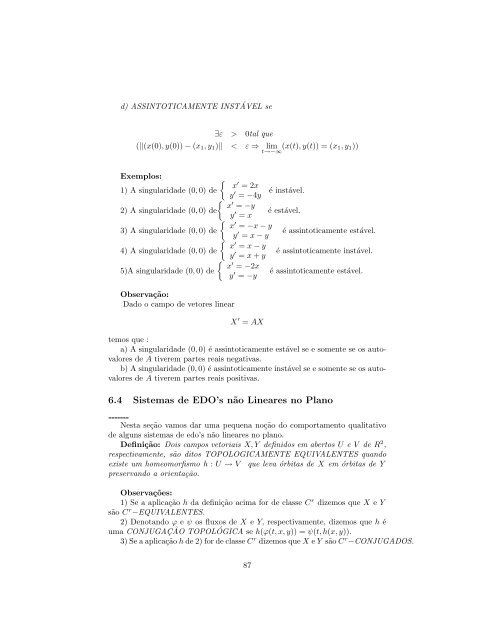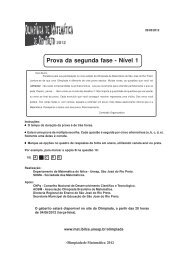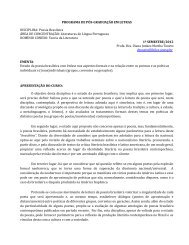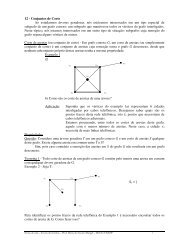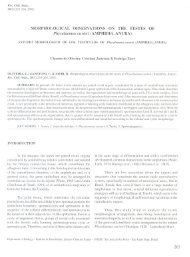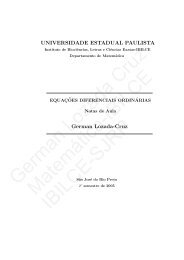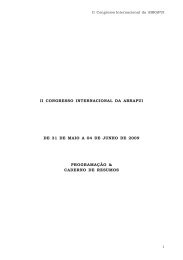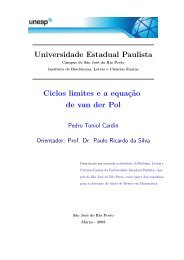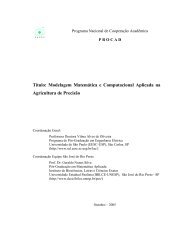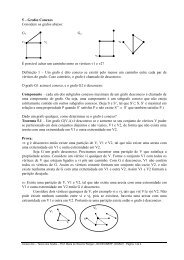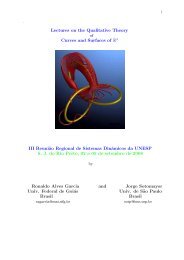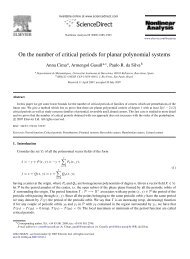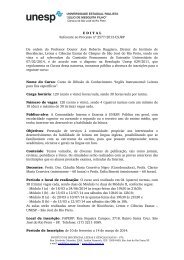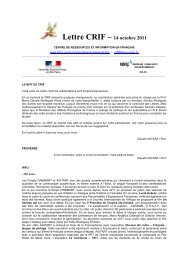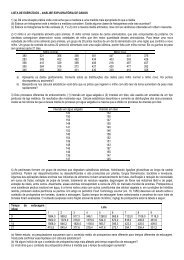Curso de Equações Diferenciais Ordinárias - Unesp
Curso de Equações Diferenciais Ordinárias - Unesp
Curso de Equações Diferenciais Ordinárias - Unesp
You also want an ePaper? Increase the reach of your titles
YUMPU automatically turns print PDFs into web optimized ePapers that Google loves.
d) ASSINTOTICAMENTE INSTÁVEL se<br />
∃ε > 0tal que<br />
(||(x(0), y(0)) − (x 1 , y 1 )|| < ε ⇒ lim<br />
t→−∞ (x(t), y(t)) = (x 1, y 1 ))<br />
Exemplos:<br />
{ x<br />
1) A singularida<strong>de</strong> (0, 0) <strong>de</strong><br />
′ = 2x<br />
y ′ = −4y é instável.<br />
{ x<br />
2) A singularida<strong>de</strong> (0, 0) <strong>de</strong><br />
′ = −y<br />
y ′ é estável.<br />
{<br />
= x<br />
x<br />
3) A singularida<strong>de</strong> (0, 0) <strong>de</strong><br />
′ = −x − y<br />
y ′ é assintoticamente estável.<br />
{<br />
= x − y<br />
x<br />
4) A singularida<strong>de</strong> (0, 0) <strong>de</strong><br />
′ = x − y<br />
y ′ é assintoticamente instável.<br />
{<br />
= x + y<br />
x<br />
5)A singularida<strong>de</strong> (0, 0) <strong>de</strong><br />
′ = −2x<br />
y ′ é assintoticamente estável.<br />
= −y<br />
Observação:<br />
Dado o campo <strong>de</strong> vetores linear<br />
X ′ = AX<br />
temos que :<br />
a) A singularida<strong>de</strong> (0, 0) é assintoticamente estável se e somente se os autovalores<br />
<strong>de</strong> A tiverem partes reais negativas.<br />
b) A singularida<strong>de</strong> (0, 0) é assintoticamente instável se e somente se os autovalores<br />
<strong>de</strong> A tiverem partes reais positivas.<br />
6.4 Sistemas <strong>de</strong> EDO’s não Lineares no Plano<br />
Nesta seção vamos dar uma pequena noção do comportamento qualitativo<br />
<strong>de</strong> alguns sistemas <strong>de</strong> edo’s não lineares no plano.<br />
Definição: Dois campos vetoriais X, Y <strong>de</strong>finidos em abertos U e V <strong>de</strong> R 2 ,<br />
respectivamente, são ditos TOPOLOGICAMENTE EQUIVALENTES quando<br />
existe um homeomorfismo h : U → V que leva órbitas <strong>de</strong> X em órbitas <strong>de</strong> Y<br />
preservando a orientação.<br />
Observações:<br />
1) Se a aplicação h da <strong>de</strong>finição acima for <strong>de</strong> classe C r dizemos que X e Y<br />
são C r −EQUIVALENTES.<br />
2) Denotando ϕ e ψ os fluxos <strong>de</strong> X e Y, respectivamente, dizemos que h é<br />
uma CONJUGAÇÃO TOPOLÓGICA se h(ϕ(t, x, y)) = ψ(t, h(x, y)).<br />
3) Se a aplicação h <strong>de</strong> 2) for <strong>de</strong> classe C r dizemos que X e Y são C r −CONJUGADOS.<br />
87


